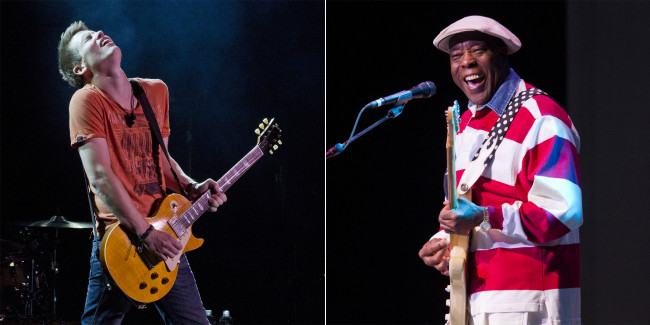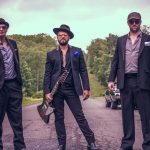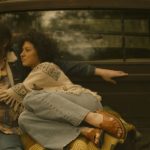Blues legends Buddy Guy and Jonny Lang perform at Penn’s Peak in Jim Thorpe on July 20

From a press release:
It was announced today that Grammy Award-winning blues guitar legends Buddy Guy and Jonny Lang are teaming up again for another tour that stops at Penn’s Peak in Jim Thorpe on Friday, July 20 at 8 p.m.
Tickets, which are $52 for regular reserved seating and $62 for the pit (standing room only), go on sale next Friday, April 27 at 10 a.m. and will be available at ticketmaster.com and all Ticketmaster outlets, the Penn’s Peak box office (325 Maury Rd., Jim Thorpe), and Roadies Restaurant and Bar (325 Maury Rd., Jim Thorpe). Penn’s Peak box office and Roadies Restaurant ticket sales are walk-up only; no phone orders.
At age 81, Buddy Guy is a Rock and Roll Hall of Fame inductee; a major influence on rock titans like Jimi Hendrix, Eric Clapton, and Stevie Ray Vaughan; a pioneer of Chicago’s fabled West Side sound; and a living link to the city’s halcyon days of electric blues. He has received seven Grammy Awards, a 2015 Lifetime Achievement Grammy, 37 Blues Music Awards (the most any artist has received), the Billboard Magazine Century Award for distinguished artistic achievement, a Kennedy Center Honor, and the Presidential National Medal of Arts. Rolling Stone Magazine ranked him No. 23 in its “100 Greatest Guitarists of All Time” list.
Guy released his latest studio album, “Born to Play Guitar,” on July 31, 2015 via Silvertone/RCA Records, which debuted at No. 1 on Billboard’s Top Blues Albums chart. The follow-up to his 2013 first-ever double disc release, “Rhythm & Blues,” which also debuted at No. 1 on Billboard’s Top Blues Albums chart, “Born to Play Guitar” was produced by Grammy-winning producer/songwriter and Buddy’s longtime collaborator Tom Hambridge. The release features guest appearances by Van Morrison, Joss Stone, Kim Wilson, and Billy Gibbons.
Though Guy will forever be associated with Chicago, his story actually begins in Louisiana. One of five children, he was born in 1936 to a sharecropper’s family and raised on a plantation near the small town of Lettsworth, located some 140 miles northwest of New Orleans. He was just 7 years old when he fashioned his first makeshift “guitar,” a two-string contraption attached to a piece of wood and secured with his mother’s hairpins.
In 1957, he took his guitar to Chicago, where he would permanently alter the direction of the instrument, first on numerous sessions for Chess Records playing alongside Howlin’ Wolf, Muddy Waters, and the rest of the label’s legendary roster, and then on recordings of his own. His incendiary style left its mark on guitarists from Jimmy Page to John Mayer. “He was for me what Elvis was probably like for other people,” said Eric Clapton at Guy’s Rock and Roll Hall of Fame induction in 2005. “My course was set, and he was my pilot.”
Seven years later, July 2012 proved to be one of Buddy Guy’s most remarkable years ever. He was awarded the 2012 Kennedy Center Honor for his lifetime contribution to American culture. Earlier in the year, at a performance at the White House, he even persuaded President Barack Obama to join him on a chorus of “Sweet Home Chicago.” Also in 2012, he published his long-awaited memoir, “When I Left Home.”
Years later, Buddy Guy is a genuine American treasure and one of the final surviving connections to an historic era in the country’s musical evolution. He keeps looking to the future of the blues through his ongoing work with his 18-year-old protégé, Quinn Sullivan.
“I worry a lot about the legacy of Muddy, Wolf, and all the guys who created this stuff,” he says. “I want people to remember them. It’s like the Ford car – Henry Ford invented the Ford car and, regardless how much technology they got on them now, you still have that little sign that says ‘Ford’ on the front.
“One of the last things Muddy Waters told me – when I found out how ill he was, I gave him a call and said, ‘I’m on my way to your house.’ And he said, ‘Don’t come out here, I’m doing all right. Just keep the damn blues alive.’ They all told me that if they left here before I did, then everything was going to be on my shoulders. So as long as I’m here, I’m going to do whatever I can to keep it alive.”
It is hard to believe that at 37 years old, Jonny Lang has already had a successful career for two decades.
Easier to believe when you learn he released his first platinum record at 15, an age when many young people are just beginning to play music. “Lie to Me” revealed a talent that transcended the crop of blues prodigies floating around in the late 1990s. No flashy re-hasher of classic blues licks, even at that early age, Lang was a full-blown artist with a style of his own. Also, setting Lang apart from the wunderkind crowd was a 15-year-old voice that sounded like a weathered soul shouter. Actual life experience was yet to come and has been subsequently chronicled in a series of five uniformly excellent recordings.
“I got married, had kids, and that arc has been recorded on albums along the way,” says Lang. “There is a lot of personal history in there and also some things that relate to world events.”
What began as a bluesy sound influenced by electric pioneers like Albert Collins, B.B. King, and Buddy Guy evolved over those recordings into a modern R&B style closer to Stevie Wonder and contemporary gospel music. Lang’s distinctive, blues-inflected licks appeared on every album but became one element in a sea of passionately sung and tightly arranged songs.
2017’s “Signs” is not merely a return the artist’s guitar-based beginnings, but an embodiment of an even more elemental sound. Beyond focusing attention on his soloing prowess, it is about recapturing the spirit of the early blues, where the guitar was front and center, fairly leaping out of the speakers.
“A lot of my earlier influences have been coming to the surface, like Robert Johnson and Howlin’ Wolf,” he reports. “I have been appreciating how raw and unrefined that stuff is. I had an itch to emulate some of that and I think it shows in the songs. Still, I let the writing be what it was, and that was sometimes not necessarily the blues.”
In this simpler spirit, Lang, Drew Ramsey, and Shannon Sanders convened in a Los Angeles studio with some melodic and arranging ideas and proceeded to crank out a dozen basic tracks in a few days. With a bit of overdubbing and further recording in Los Angeles and Nashville – and some further help from Dwan Hill, Dennis Dodd and Josh Kelley – “Signs” was done. The record, which features funk, rock, and blues elements, is held together by Lang’s distinctive playing and singing, and the lyrics, which center on themes of embattlement and self-empowerment.
“Some of the songs are autobiographical, but not usually in a literal way,” Lang explains. “The main goal is for folks to be able to relate to what I went through. If I can’t make it work using just my personal experience, I use my imagination to fill in blanks.”
Since the release of his debut album, the Grammy-winning artist has built a reputation as one of the best live performers and guitarists of his generation. The path Lang has been on has brought him the opportunity to support or perform with some of the most respected legends in music. He has shared the stage with everyone from The Rolling Stones to B.B. King to Aerosmith to Buddy Guy, who he continues to tour with today.
Fans who discovered Lang through his searing instrumental work will revel in the huge guitar tones and go-for-broke solos on “Signs,” while those who have appreciated his growth as an honest and passionate songwriter will find that honesty and passion unabated. Though he long ago left blues purism behind, Lang has never abandoned its spirit of universal catharsis through the relating of personal trials. “Signs” reaffirms his commitment to the blues and the guitar without sacrificing the modern approach that has made him such a singular artist.
Photos by Jason Riedmiller Photography/NEPA Scene



